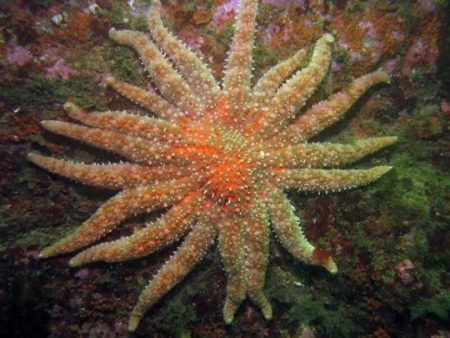
The last time Cannon Beach’s Haystack Rock Awareness Program recorded a sighting of a sunflower sea star was in 2019.
They are one of the largest sea stars in the world, measuring up to one meter across, with as many as 20 arms. Voracious predators, they feed on urchins, fish and even birds. For visitors to Haystack Rock, they could be a dramatic sight during extreme low tides.
The staff nickname for them is “the great whites of the tide pools.” But this particular specimen was more of a minnow: about the size of a fingertip, with only 10 arms.
A major outbreak of the deadly sea star wasting syndrome decimated sea star populations between 2013 and 2017. Researchers estimate sunflower sea star numbers declined by as much as 99% off the California, Oregon and Washington state coasts.
Last week, the National Oceanic and Atmospheric Administration announced a proposal to list the sunflower sea star as threatened. If the proposal moves forward, it would put a sea star on the Endangered Species List for the first time.
For the Haystack Rock Awareness Program, the presence of certain sea star species acts as a sort of baseline, a marker for how the ecosystem is doing.
“So when we see a sunflower star we know we’re doing really well,” Habecker said.
The continued absence of the species around the rock today — the 2019 sighting notwithstanding — is troubling.
Habecker says NOAA’s proposal to list the sunflower sea star is “a step in the right direction.”
Little is known about even the basics of the sunflower sea star’s life history, and listing could help researchers pursue gaps in their knowledge and further investigate the continued impact of the wasting syndrome.
“It does bring some regulatory and some financial and some outreach and collaboration opportunities that wouldn’t otherwise necessarily be there at the federal level,” said Dayv Lowry, a fisheries biologist with NOAA who helped lead a status review of the species.
The sunflower sea star is an important predator of sea urchins. With the decline of sea star species due to the wasting syndrome — and the loss of other predators such as otters over the years — urchin populations have boomed in some areas off Oregon, threatening kelp forests that shelter key marine species including fish important to local fisheries.
Researchers worry that without a robust population of certain sea stars, urchins could continue to proliferate and destroy Oregon’s kelp forests in much the same way they have leveled kelp forests off the California coast.
Recovery of sea star species along the West Coast has been uneven in general after the wasting pandemic. At Haystack Rock, the awareness program is only barely beginning to see signs of recovery among ochre sea stars during regular surveys.
Lowry and other researchers say there are many places where healthy populations of sunflower sea stars still exist and there are broad swaths of territory where the animals could live. Approximately 600 million sunflower sea stars live in the wild.
But their loss from local waters was profound.
NOAA’s status review noted that the wasting syndrome continues to be the biggest threat to the animal — even greater than habitat loss and certain impacts of human-caused climate change.
The root cause of the sea star wasting syndrome remains unknown and its link to climate change is, as Lowry puts it, “an interesting one.”
The wasting syndrome is affected by warming water temperatures, but Lowry added, “It’s also affected by just large changes in water temperatures.”
Warmer ocean waters are one consequence of global warming. Climate change also brings more active storm fronts and more movement of water.
“So, ultimately, it’s this change in water,” Lowry said. “The difference between what they’re experiencing prior and then post an event. So cold water, warm water: Both of these things may be active triggers of sea star wasting syndrome.”
NOAA’s listing proposal now goes out for a 60-day public comment period. A decision on whether to list the sunflower sea star will be made sometime in the next 12 months.
